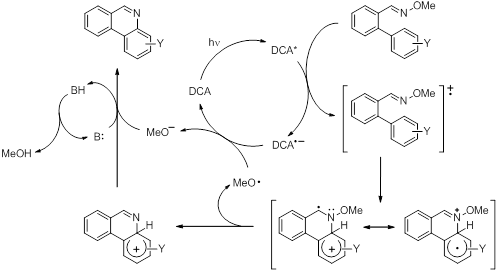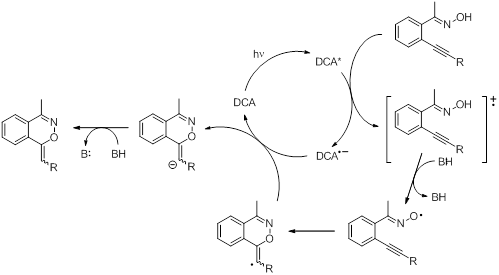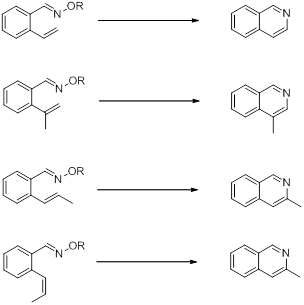Reports: UR453793-UR4: Mechanistic Studies of Radical and Radical Ion Intermediates in Oxidative Processes
H. J. Peter De Lijser, California State University (Fullerton)
Research in our group focuses on the electron transfer chemistry of the carbon-nitrogen double bond. Of particular interest are oximes and oxime ethers because of their stability (compared to imines), their use as protection groups in organic synthesis, and the increasing use of these compounds in pharmaceuticals. Photooxidation or enzymatic oxidation may result in the formation of reactive species, such as radical ions or free radicals, which can cause damage to cells and tissue in biological systems. Our goal is to investigate the oxidative chemistry of oximes and related species and to obtain a complete understanding of the involvement of reactive intermediates in these processes.
In recent years we have shown oxidation of oximes leads to iminoxyl radicals as intermediates whereas oxidation of oxime ethers produces oxime ether radical cations. The different chemistry observed for each of these species is being explored for synthetic utilization. Of particular interest is to see whether we can perform intramolecular cyclization reactions to generate interesting heterocyclic structures. To do so we are exploring the intramolecular trapping of the radical and radical ion species with built-in alcohol groups, aromatic rings, alkynes, and alkenes.
One project has focused on the use of built-in alcohol groups as the nucleophile. We have succeeded in our goal to prepare g-hydroxy-1-phenylbutanone oxime ethers (Figure 1). The substrate was studied in a variety of (deuterated) solvents and with different sensitizers; all reactions were followed by NMR.
Figure 1. Set of hydroxyoxime ethers used for studies of intramolecular cyclization reactions of oxime ether radical cations.
Reactions carried out in benzene did not show any product formation; reactions proceeded better in acetonitrile. On the basis of NMR analysis, a cyclization reaction seemed to occur, and the data seems most consistent with the product shown in Scheme 1, which is consistent with our prediction. We are currently further optimizing the reactions in order to be able to scale them up and isolate the product from the reaction.
Scheme 1. Proposed cyclized product formed in the reactions of a series of g-hydroxy-1-phenylbutanone oxime ethers.
Much of our foundational work in this particular area has been done using a series of o-arylbenzaldehyde oxime ethers (Figure 2) as well as a series of o-alkynylacetophenone and benzaldehyde oximes and oxime ethers (Figure 3).
Figure 2. Set of o-aryl benzaldehyde oxime ethers used for studies of intramolecular cyclization reactions of iminoxyl radicals and oxime ether radical cations.
Figure 3. Set of o-alkynylaryl oximes and oxime ethers used for studies of intramolecular cyclization reactions of iminoxyl radicals and oxime ether radical cations.
Both oximes and oxime ethers were studied but only oxime ethers were found to give satisfactory results in terms of cyclization, suggesting that the reactions proceed via the oxime ether radical cation. Under the conditions of the reaction, the photoinduced electron transfer (PET) process was found to be catalytic in nature and good yields and regioselectivity of phenanthridines could be obtained when using substituted aromatic rings (Scheme 2).
Scheme 2. Proposed mechanism for the formation of phenanthridines from the 2’-arylbenzaldehyde O-methyl oxime ether radical cation intermediate.
To learn about the alkyne moiety and its behavior as a radical trap or a nucleophile, a variety of different alkyne containing substrates (oximes and oxime ethers) were prepared and studied. Both photochemical and thermal oxidations were carried out and the reactions were followed by GC/MS and NMR. Cyclization is believed to occur in several cases but only for oximes, suggesting an iminoxyl radical intermediate. More interestingly, the cyclization seems to be an exo-type cyclization (Scheme 3), which has not been observed for these types of species. More recently we have started a collaboration with a theoretical chemist (Dr. Andrew Petit) who computational chemistry to calculate and predict NMR spectra of the proposed cyclic structures. Comparison of the theoretical spectra to those of the experimentally observed spectra shows good agreement in some cases, whereas in others there is a clear discrepancy. We are currently further exploring these reactions to obtain better data in terms of the intermediates and the pathways.
Scheme 3. Proposed mechanism for the catalytic oxidative cyclization of o-alkynylaryl oximes.
Since the alkyne and aromatic substrates discussed above seem to react differently, we have recently set out to prepare a set of alkene-containing substrates (Figure 4) to determine their reactivity; it is possible that these substrates will display features of both sets. The synthesis of these substrates has been difficult but some progress has been made.
Figure 4. Set of o-alkenylaryl oximes and oxime ether used for studies of intramolecular cyclization reactions of iminoxyl radicals and oxime ether radical cations.
Preliminary data for photolysis reactions show interesting results. NMR analysis of the reaction mixtures suggests that in some cases the same product is observed when using the oxime or the oxime ether. The most promising results were obtained with the isopropenyl derivative (oxime ether) and we are currently looking to further optimize the reaction in order to be able to scale it up and isolate the product(s). Results from the E- and Z-propenyl derivatives are more complicated. The NMR spectra show the formation of a signal (quartet) at ~9.72 ppm, suggesting a nearby methyl group. The coupling constant is 2.81 Hz, indicating a long-distance coupling. Based on the results of previous studies, potential cyclized products could include those shown in Scheme 4. For the vinyl derivative, this seems to be a correct hypothesis (comparison of product mixture to authentic isoquinoline NMR spectrum). However, comparison of the E- and Z-propenyl product mixtures to the NMR spectrum of 3-methylisoquinoline shows distinct differences. In addition we have found that oximes and oxime ethers behave the same leading to identical products. This is in clear contrast with previous observations from our lab. Theoretical studies (by our collaborator) on the potential cyclic products have not yet revealed any solid candidates that would be consistent with either of the previously identified pathways so we are continuing our efforts on identifying potential products.
Scheme 4. Proposed products for the catalytic oxidative cyclization of o-alkenylaryl oximes.



















